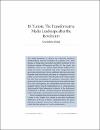Tunisia: The Transformative Media Landscape after the Revolution
| Author | Miladi, Noureddine |
| Available date | 2022-01-30T06:55:55Z |
| Publication Date | 2021 |
| Publication Name | Arab Media Systems |
| Identifier | http://dx.doi.org/10.11647/OBP.0238.16 |
| ISBN | 978-1-80064-059-7 |
| ISBN | 978-1-80064-061-0 |
| Abstract | The media landscape in Tunisia has witnessed significant transformations since the revolution of 14 January 2011. After decades of being direct controlled and tightly monitored by the dictatorial regimes of Bourguiba and Ben Ali, the country has shifted to a new era of a diverse media market. Public service media have been consolidated and made independent from government interference. Newly established television and radio channels have been thriving and stand in competition with the public service broadcasters. This diversity in the media market has also been accompanied by regulatory frameworks which guarantee free speech and the independence of journalists. In spite of its slow development, the independent television and radio regulator Haute Autorité Indépendante de la Communication Audiovisuelle (High Independent Authority of the Audiovisual Commission, or HAICA), has been integral in transforming the nature of the audio-visual market to meet international standards. However, despite these recent advances in media development, I argue in this chapter that, similar to any other transitional democracy, in the case of Tunisia, ideological forces, the power of business magnates, and overseas influences remain key factors which affect the operation of various media outlets. |
| Language | en |
| Publisher | Open Book Publishers |
| Subject | Tunisia, Arab media, social change, broadcasting, Arab Spring Revolutions, media systems Tunisia Arab media social change broadcasting Arab Spring Revolutions media systems |
| Type | Book chapter |
| Pagination | 267-284 |
Files in this item
This item appears in the following Collection(s)
-
Mass Communication [75 items ]




